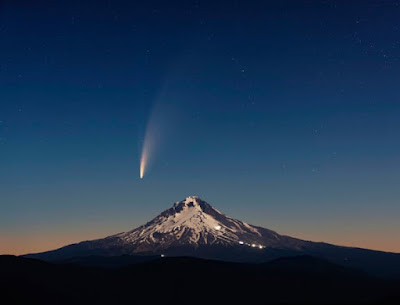 |
| Comet NEOWISE over Mount Hood on July 11, 2020. Credit: Kevin Morefield Getty Images |
Topics: Astronomy, Astrophysics, Comets
Comet NEOWISE has been entertaining space enthusiasts across the Northern Hemisphere. Although its official name is C/2020 F3, the comet has been dubbed NEOWISE after the Near-Earth Object Wide-Field Infrared Survey Explorer (NEOWISE) space telescope that first noticed it earlier this year. This “icy snowball” with a gassy tail made its closest approach to the sun on July 3 and is now heading back from whence it came: the far reaches of the outer solar system. Its long, looping orbit around our star ensures that after passing closest to Earth on July 22, Comet NEOWISE will not return for some 6,800 years.
Even though the comet is now bright enough to observe with unaided eyes, inexperienced stargazers might have trouble knowing when and where to look. Scientific American spoke to Jackie Faherty, an astronomer at the American Museum of Natural History in New York City, for observing tips and a better appreciation of why comets are so special.
How does one prepare to watch Comet NEOWISE with the naked eye?
Find the darkest possible swath of sky and make sure your eyes are adjusted so that you give yourself the best possible opportunity to see faint objects. It means: don’t just walk outside after staring at lights or screens and expect to see [the comet] really well. You need 15 minutes or so to adjust your eyes, so that your pupils are adjusted, and they’re used to seeing fainter things. It’s the same as walking into a dark room, and everybody knows that [you] can’t see [things] first—and then, all of a sudden, you start seeing things. You need to do the same thing when you walk outside. And use the Comet NEOWISE app developed by astrophysicist Hanno Rein of University of Toronto Scarborough to see exactly where it is, so that you know what direction you need to look. And then the key would be to find yourself a place that is the darkest possible, that [has] no lights.
The Best Way to Watch Comet NEOWISE, Wherever You Are, Karen Kwon, Scientific American
Comments